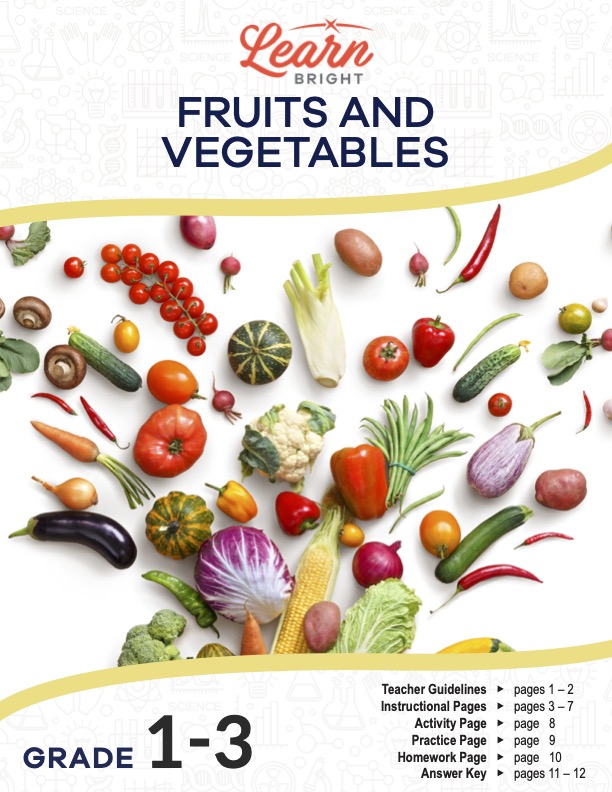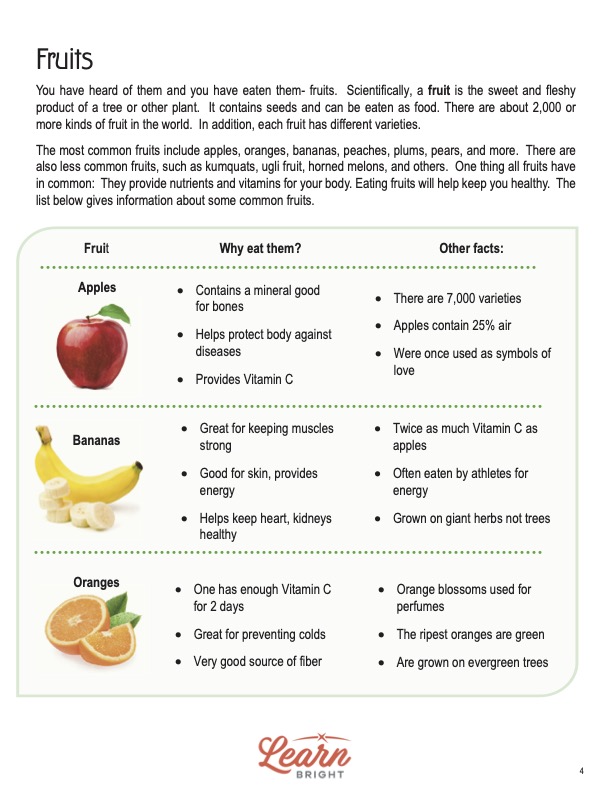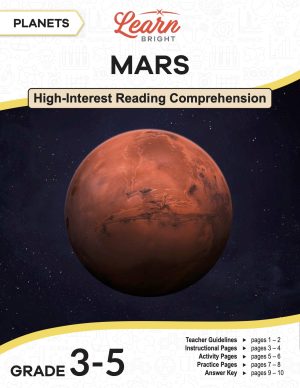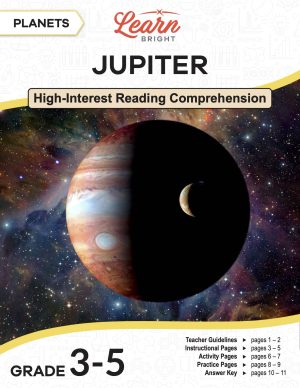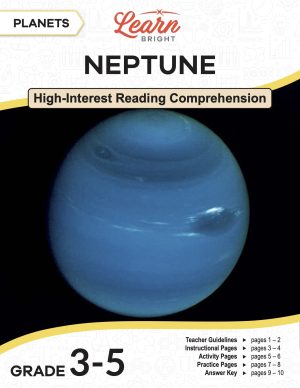Description
What our Fruits and Vegetables lesson plan includes
Lesson Objectives and Overview: Fruits and Vegetables teaches students about the differences between foods that fall into these two categories. Students will be able to define and explain what each type of food is. They will also discover some of the health benefits that come from eating fruits and veggies. This lesson is for students in 1st grade, 2nd grade, and 3rd grade.
Classroom Procedure
Every lesson plan provides you with a classroom procedure page that outlines a step-by-step guide to follow. You do not have to follow the guide exactly. The guide helps you organize the lesson and details when to hand out worksheets. It also lists information in the yellow box that you might find useful. You will find the lesson objectives, state standards, and number of class sessions the lesson should take to complete in this area. In addition, it describes the supplies you will need as well as what and how you need to prepare beforehand. This lesson requires various fruits or vegetables, plastic knives, drawing paper, and colored pencils.
Options for Lesson
In the “Options for Lesson” section of the classroom procedure page, you will find several suggestions for ideas and activities to add to the lesson. One idea is to plan a “Fruits and Veggies Day” (or week), or have separate days for each food group. You could haves students and/or their parents bring a fruit or vegetable dish to share. Another option is to invite a nutritionist to speak with the class and answer questions they have. You could assign each student a different fruit or vegetable to research and later present to the class. Students could also design and create a fruit or vegetable costume to wear on a special day. As another activity, students could collect images of fruits and vegetables and make collages. One more idea is to create a skit for students to perform that explains the differences between fruits and vegetables.
Teacher Notes
The teacher notes page provides an extra paragraph of information to help guide the lesson and remind you what to focus on. It suggests you gather several fruits and vegetables for students to sample throughout the lesson. The blank lines on this page are available for you to write out thoughts and ideas you have as you prepare the lesson.
FRUITS AND VEGETABLES LESSON PLAN CONTENT PAGES
Plants
The Fruits and Vegetables lesson plan has four pages of content. Plants are everywhere. On every continent throughout the world are different kinds of plants. Some people grow plants inside their homes. They care for their plants by watering them and giving them sunlight and good soil. Other people have gardens in their backyard, shrubs and flowers, and most likely grass.
Regardless of where they are, nearly all plants need several things to grow. Such things include sunlight for photosynthesis, which is the process plants use to make their own food. Plants also need nutrients from the soil, air or oxygen, and water. In addition, they need the right temperature and enough room to grow properly.
Plants are living organisms, just like animals or people. There are thousands and thousands of different species throughout the world. They can be very tiny or as large as a building. The smallest plant in the world is called a watermeal and is about the size of a grain of rice. The largest plant is a tree called the giant sequoia.
However, the plants a majority of people rely on the most are not the biggest or the smallest. These plants are the ones that produce fruits and vegetables. It is almost impossible to eat meals throughout the day that do not include at least one vegetable or fruit. Why? Because fruits and vegetables are healthy food choices. However, how do they help us, and what is the difference between the two?
Fruits
Scientifically, a fruit is the sweet and fleshy product of a tree or other plant. It contains seeds and can be eaten as food. There are about 2,000 or more kinds of fruit in the world. In addition, each fruit has different varieties. For instance there are honeycrisp, Fuji, and granny smith apples.
Some of the most common fruits include apples, oranges, bananas, peaches, plums, pears. Less common or lesser known fruits include kumquats, ugli fruit, and horned melons. One thing all fruits have in common is that they provide nutrients and vitamins for the body. Eating fruits will help keep us healthy. The lesson provides a list of common fruits and the nutrients they provide.
Bananas, for instance, are great for keeping muscles strong and providing energy. In fact, athletes often eat bananas because they provide energy. Bananas also keep the heart and kidneys healthy. In addition, they contain almost twice as much vitamin C as apples. Contrary to popular belief, bananas grow on giant herbs, not on trees.
One way to tell the difference between a fruit and vegetable is to look for seeds. Nearly all fruits have seeds that develop from a flowering plant. On the other hand, vegetables are usually the other parts of a plant, such as its roots, leaves, or stems. Sometimes people argue whether a tomato is a fruit or vegetable because it has seeds but isn’t necessarily sweet. Scientifically, the tomato is a fruit!
Vegetables
People generally eat plenty of vegetables throughout the week, sometimes not without even realizing it. Many vegetables are added to other foods for flavoring. For example, onions can be found on top of hamburgers or mixed in with spaghetti sauce. Scientifically, a vegetable is a plant or part of a plant used as food.
No one knows the exact number of vegetable types in the world, but it is safe to say there are thousands. If it is possible to eat the stem, leaf, or root of a plant, that plant can safely be considered a vegetable. The animals that eat grass and leaves are actually eating vegetables.
And just like fruits, there are common and uncommon vegetables, but they are all good for our health. The most popular vegetable in the world (meaning the one people eat the most of) might be the potato. This is because of the different foods we can make with potatoes, like french fries or potato chips. The lesson provides another list of common vegetables and information about each one.
As an example, lettuce is a vegetable that contains 95% water! It helps contribute to healthy skin, good vision, and a good immune system. It is a popular salad vegetable and is actually a member of the sunflower family. The darker the lettuce, the more nutritious that variety is.
FRUITS AND VEGETABLES LESSON PLAN WORKSHEETS
The Fruits and Vegetables lesson plan includes three worksheets: an activity worksheet, a practice worksheet, and a homework assignment. Each one will reinforce students’ comprehension of lesson material in different ways and help them demonstrate when they learned. Use the guidelines on the classroom procedure page to determine when to distribute each worksheet to the class.
EXAMINATION ACTIVITY WORKSHEET
Students will work with a partner for the activity. You will provide each pair of students a fruit or vegetable. Students will write the name of the food they received and describe some of the benefits it has using the content pages. Then they will describe a time when they ate that fruit or vegetable previously, particularly describing its taste.
Next, students will draw a picture of their food on a piece of scratch paper that has as much detail as possible. They can use a separate sheet of paper to create a final drawing. After drawing pictures of the various produce, students will cut them open and draw a second picture of the inside. Finally, they will answer the questions at the bottom of the page.
CIRCLE AND UNDERLINE
The practice worksheet contains a list of lots of different fruits and vegetables. Students must determine which are which. They will circle all the foods that are vegetables and underline all the foods that are fruits.
FRUITS AND VEGETABLES HOMEWORK ASSIGNMENT
For the homework assignment, students will first rank their favorite fruits and vegetables. The worksheet provides a list of 11 foods for each category in their own tables. Students will rank the foods from their most favorite (1) to least favorite (11) in the first column. If they have never eaten one of the foods, they will write a 0 instead. Then they will have a parent or sibling fill out the second column with their own ranking. The second section requires students to mark eight statements as either true (T) or false (F).
Worksheet Answer Keys
The lesson plan document provides answer keys for both the practice and homework worksheets. For the practice worksheet, the correct answers are in red and green, red for fruits and green for vegetables. The homework assignment shows the correct answers in red for the second section. Students’ answers will vary on the first section of this assignment. If you choose to administer the lesson pages to your students via PDF, you will need to save a new file that omits these pages. Otherwise, you can simply print out the applicable pages and keep these as reference for yourself when grading assignments.

